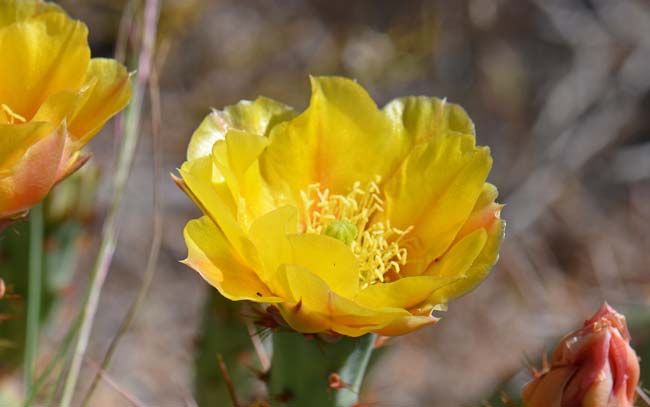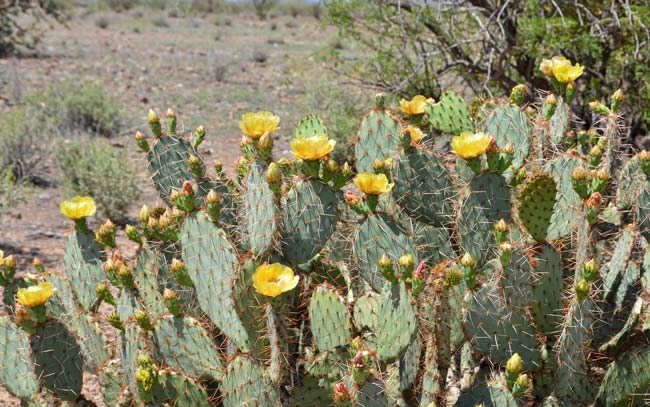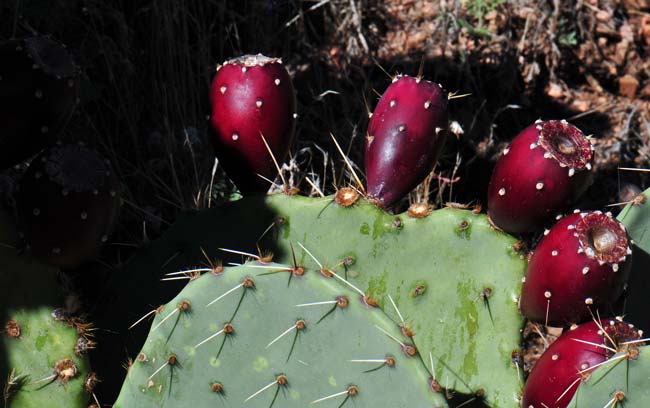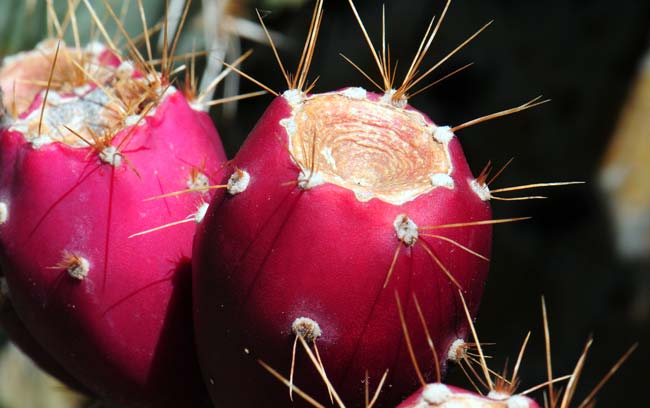Opuntia engelmannii, Cactus Apple




Scientific Name: Opuntia engelmannii
Common Name: Cactus Apple
Also Called: Cow's Tongue Prickly Pear, Engelmann Prickly Pear, Engelmann Pricklypear, Tuna; (Spanish: Nopal, Abrojo, Joconostle, Vela de Coyote)
Family: Cactaceae, Cactus Family
Synonyms: (Opuntia phaeacantha var. discata)
Status: Native
Duration: Perennial
Size: Up to 4 or 5 or rarely 8 feet tall.
Growth Form: Shrub, Tree with short trunk; spreading to sometimes decumbent; stem segments yellow-green to blue-green, flattened (pads), glabrous, circular to obovate to rhombic.
Leaves: Spines evenly distributed on pad or absent, white to yellow, aging gray to blackish, spines straight to curbed; glochids widely spaced, yellow to red-brown aging gray or blackish.
Flower Color: Yellow throughout, or sometimes orange to pink to red and rarely whitish; flowers diurnal; filaments, anthers and style whitish to cream, stigma lobes yellow-green to green; fruit (called tunas) dark red to purple throughout, ovate-elongate to barrel-shaped, juicy, bleeding and staining, glabrous and spine-less, seeds tan to grayish.
Flowering Season: April to July.
Elevation: 1,000 to 9,000 feet.
Habitat Preferences: Sandy, gravelly or rocky soils, slopes, bajadas and flats.
Recorded Range: In the United States Opuntia engelmannii is found primarily in the southwest but also in the southern states in; AZ, CA, LA, MO, MS, NM, NV, OK, TX, UT. It is also native throughout Baja California and Mexico. In Arizona is occurs throughout the central, north- and south-central and southeast parts of the state.
North America & US County Distribution Map for Opuntia engelmannii.
U.S. Weed Information: No information available.
Invasive/Noxious Weed Information: No information available.
Wetland Indicator: No information available.
Threatened/Endangered Information: Arizona: Opuntia engelmannii is salvage restricted.
Genus Information: In North America there are 52 species for Opuntia. Worldwide, The Plant List includes 194 accepted species names and a further 203 scientific names of infraspecific rank for the genus.
In the Southwestern United States: Arizona has 16 species of Opuntia, California and Utah each have 10 species, Nevada has 6 species, New Mexico has 13 species, Texas has 23 species. All data is approximate and subject to taxonomic changes.
There are 6 varieties in Opuntia engelmannii:
Opuntia engelmannii var. cuija, Cactus Apple; (AZ)
Opuntia engelmannii var. engelmannii, Cactus Apple; (AZ, CA, NM, NV, TX, UT)
Opuntia engelmannii var. flavispina, Cactus Apple; (AZ)
Opuntia engelmannii var. flexospina, Cactus Apple; (TX)
Opuntia engelmannii var. lindheimeri, Texas Pricklypear; (LA, MO, MS, OK, NM, TX)
Opuntia engelmannii var. linguiformis, Cactus Apple; (TX).
Comments: Cactus Apple is a common Prickly Pear in the southwestern United States. It has beautiful showy large yellow flowers and striking deep red or magenta large fruit.
Opuntia engelmannii was named in honor of George Engelmann, (1809-1884) was a German-American botanist.
Early Pricklypear species and varieties classified as Cactus Apple, Opuntia engelmannii, were reviewed and placed with Tulip Pricklypear, Opuntia phaeacantha, for which it could be confused as a similar looking species.
In Southwest Desert Flora also see: Beavertail Pricklypear, Opuntia basilaris; Long-spined Prickly Pear, Opuntia macrocentra; Twistspine Pricklypear, Opuntia macrorhiza; Tulip Pricklypear, Opuntia phaeacantha and Santa Rita Pricklypear, Opuntia santa-rita.
Candy Apple Pricklypear has been used for fruit and food by southwestern United States indigenous peoples.
See complete listing of ethno-botanical uses at Native American Ethnobotany, University of Michigan, Dearborn.

